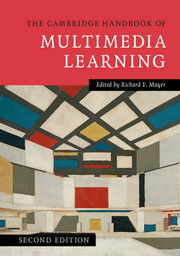Crossref Citations
This Book has been
cited by the following publications. This list is generated based on data provided by Crossref.
Boucheix, Jean-Michel
and
Rouet, Jean-François
2007.
Les animations interactives multimédias sont-elles efficaces pour l’apprentissage ?.
Revue française de pédagogie,
p.
133.
Terrier, Linda
and
Vaillant Sirdey, Christine
2011.
L’acquisition raisonnée d’un laboratoire multimédia de langues : de la théorie à la pratique.
Les Cahiers de l'APLIUT,
Vol. Vol. XXX N° 1,
Issue. ,
p.
42.
Hirsh-Pasek, Kathy
Zosh, Jennifer M.
Golinkoff, Roberta Michnick
Gray, James H.
Robb, Michael B.
and
Kaufman, Jordy
2015.
Putting Education in “Educational” Apps.
Psychological Science in the Public Interest,
Vol. 16,
Issue. 1,
p.
3.
Khim Leow, Choy
Wan Yahaya, Wan Ahmad Jaafar
Mohammad, Mariam
and
Liu, Songhao
2015.
Mobile-assisted second language learning: Speaking a second language with auditory stimuli.
Issues in Language Studies,
Vol. 4,
Issue. 2,
RundellSinger, Susan
2015.
Handbook of Science and Technology Convergence.
p.
1.
Lee, Hyunjeong
and
Mayer, Richard E.
2015.
Visual Aids to Learning in a Second Language: Adding Redundant Video to an Audio Lecture.
Applied Cognitive Psychology,
Vol. 29,
Issue. 3,
p.
445.
Rundell Singer, Susan
2015.
Handbook of Science and Technology Convergence.
p.
1.
2015.
Learning as a Generative Activity.
p.
1.
Merrienboer, Jeroen J. G.
and
Dolmans, Diana H. J. M.
2015.
Researching Medical Education.
p.
193.
Yu, P.‐T.
Wang, B.‐Y.
and
Su, M.‐H.
2015.
Lecture capture with real‐time rearrangement of visual elements: impact on student performance.
Journal of Computer Assisted Learning,
Vol. 31,
Issue. 6,
p.
655.
2015.
Learning as a Generative Activity.
p.
124.
Ayres, Paul
2015.
State‐of‐the‐Art Research into Multimedia Learning: A Commentary on Mayer's Handbook of Multimedia Learning.
Applied Cognitive Psychology,
Vol. 29,
Issue. 4,
p.
631.
Rundell Singer, Susan
2016.
Handbook of Science and Technology Convergence.
p.
1059.
De Leeuw, R. A.
Westerman, M.
Nelson, E.
Ket, J. C. F.
and
Scheele, F.
2016.
Quality specifications in postgraduate medical e-learning: an integrative literature review leading to a postgraduate medical e-learning model.
BMC Medical Education,
Vol. 16,
Issue. 1,
Fang, N.
and
Guo, Y.
2016.
Interactive computer simulation and animation for improving student learning of particle kinetics.
Journal of Computer Assisted Learning,
Vol. 32,
Issue. 5,
p.
443.
Pirkl, Gerald
Hevesi, Peter
Lukowicz, Paul
Klein, Pascal
Heisel, Carina
Gröber, Sebastian
Kuhn, Jochen
and
Sick, Bernhard
2016.
Any problems? a wearable sensor-based platform for representational learning-analytics..
p.
353.
Renkl, Alexander
2016.
Handbuch Bildungsforschung.
p.
1.
Graham, Steve
Fishman, Evan J.
Reid, Robert
and
Hebert, Michael
2016.
Writing Characteristics of Students with Attention Deficit Hyperactive Disorder: A Meta‐Analysis.
Learning Disabilities Research & Practice,
Vol. 31,
Issue. 2,
p.
75.
Johnson, Chris
McGill, Monica
Bouchard, Durell
Bradshaw, Michael K.
Bucheli, Víctor A.
Merkle, Laurence D.
Scott, Michael James
Sweedyk, Z.
Velázquez-Iturbide, J. Ángel
Xiao, Zhiping
and
Zhang, Ming
2016.
Game Development for Computer Science Education.
p.
23.
2016.
e‐Learning and the Science of Instruction.
p.
29.



